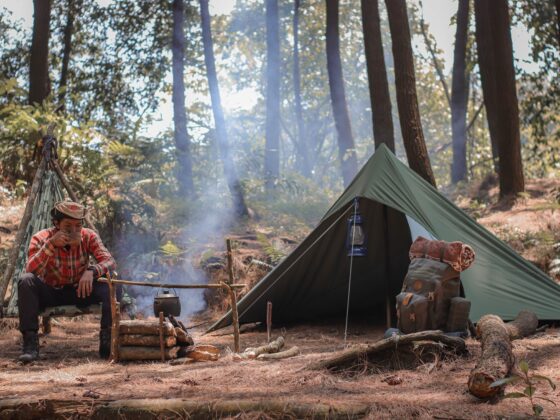For camping enthusiasts, a camping tent is an essential gear providing shelter and protection from the elements. After a camping trip, storing your tent correctly ensures its longevity and usability for future trips. Proper storage prevents mold and mildew growth and damage to the fabric and keeps your tent in good condition.
In this guide, we will provide you with some tips and tricks to help you store your camping tent correctly so it’s ready for your next outdoor adventure.
Importance of storing your tent properly
Storing your camping tent properly is crucial for maintaining its quality and longevity. A well-stored camping tent can last for years, providing reliable shelter and protection on your camping trips. On the other hand, improper storage can damage the tent’s fabric, cause mold and mildew growth, and attract insects and rodents.
Furthermore, a poorly stored tent may develop creases and folds that can be challenging to remove, and poles may get tangled or bent, rendering the tent unusable. In short, proper storage of your camping tent is essential if you want it to stay in good condition and be ready for your next outdoor adventure.
Tips to help you store your camping tent properly
Again, storing your camping tent properly ensures its longevity and usability for future camping trips.
1) Clean your tent before storing it.
Ensure it’s dry and free of debris, dirt, or stains. As such, remove any loose dirt, debris, or leaves from the tent before cleaning it.
Spot clean any stains or marks. Use a soft-bristled brush or sponge and mild soap or detergent to clean the stains. Avoid using harsh chemicals or bleach, as these can damage the fabric.
Rinse your tent with clean water. Use a hose or a bucket of clean water to rinse the tent thoroughly. Make sure to remove all the soap or detergent residue from the tent.
Dry your tent. Hang your tent in a shaded area or use a clothesline to dry it. Avoid using a dryer or direct sunlight, which can damage the fabric. Make sure that the tent is completely dry before storing it.
2) Fold your tent carefully.
Folding your camping tent properly is essential to ensure its longevity and usability for future camping trips.
Before folding your tent, make sure it is clean and dry. This will prevent mold and mildew growth and ensure it’s ready for storage.
Flatten the tent. Lay the tent flat on the ground with the doors and windows closed. Make sure all the poles are straight and untangled.
Fold the tent in half. Fold the tent in half lengthwise, bringing the two opposite corners together. Make sure the edges are aligned.
Fold the tent in thirds. Fold the tent in thirds widthwise, bringing the bottom edge up to the top edge. Smooth out any wrinkles or creases as you go.
Roll the tent. Starting from one end, roll the tent tightly towards the other end. Ensure the roll is tight, so the tent fits snugly in its storage bag.
Follow the manufacturer’s instructions on how to fold it properly. Avoid creasing or folding it in the same place repeatedly, as this can cause damage.
3) Store your tent in a cool, dry place.
Avoid storing it in direct sunlight, which can degrade the fabric and fade the colors. Also, do not expose it to moisture or humidity, which can cause mold and mildew to grow.
4) Use a storage bag or container.
A breathable storage bag is ideal, allowing air to circulate and preventing mildew growth. Use a bag that is large enough to accommodate the tent without compressing it too tightly.
5) Store your tent in a flat position.
Once your tent is dry, fold it carefully and store it in a cool, dry place. Avoid storing it in direct sunlight or damp areas as well.
Avoid hanging it, as this can cause stress on the fabric and seams.
Mistakes to avoid when storing your camping tent
Storing your camping tent is more than finding a place to dump it until your next trip. There are some common mistakes that you need to avoid to ensure the longevity of your tent.
Avoid these most common mistakes to avoid when storing your camping tent.
Storing a wet tent
Storing a wet tent can cause mold and mildew to grow, damaging the fabric and making the tent unusable. Always dry your tent thoroughly before storing it.
This is imperative even if you are using Kiwi Camp Dry Philippines or any other water-repellent tent spray.
Folding the tent incorrectly
Folding your tent incorrectly can cause creases and folds that can be difficult to remove and weaken the fabric. Follow the manufacturer’s instructions on how to fold your tent correctly.
If it does not include a proper camping tent storage guide, you may always go back to the camping equipment shop where you bought it from. They will surely gladly assist you on this matter.
Storing the tent in a damp or humid area
Storing your tent in a damp or humid area can cause mold and mildew growth and attract insects and rodents. Instead, store your tent in a dry, cool, and well-ventilated place.
Leaving the tent in its stuff sack for an extended period
Leaving your tent in its stuff sack for an extended period can cause the fabric to lose shape and weaken. Use a larger storage bag or box to store your tent.
Storing the tent with sharp objects
Storing your tent with sharp objects, such as tent stakes, rocks, or other camping gear, can puncture or tear the fabric. Store your tent separately from other camping gear.
Follow these tips to ensure your camping tent is well-preserved and ready for your next outdoor adventure.



